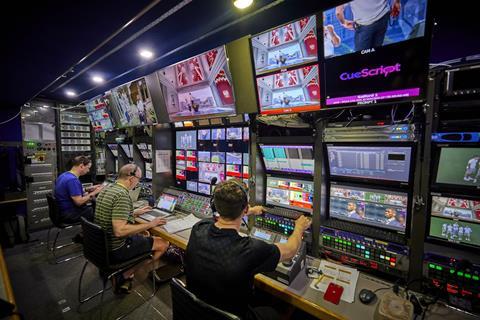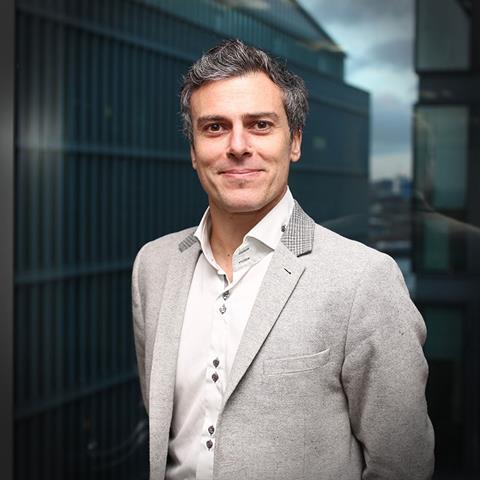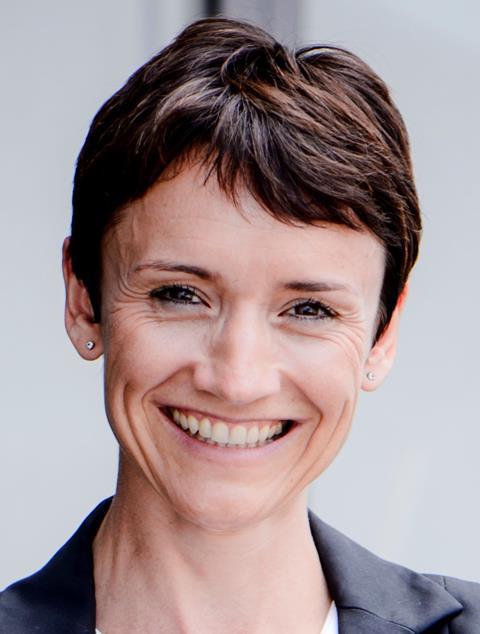Figures from across the industry give their view on the future of the medium

November 21st is World Television Day, and to mark the occasion, we asked industry leaders from across the TV ecosystem how how their sector could evolve in the future.

Richard Wormwell, head of innovation, dock10: “TV in the digital age will push the boundaries of content production to be more immersive, interactive, and engaging. We’re creating tools that allow producers to craft experiences that blend gaming elements, virtual environments, and real-time animations—moving far beyond traditional 2D broadcasts. Innovations we’re working on include virtual lighting, real-time light transfer, optical talent tracking and AI-driven compositing, all of which look to enrich storytelling possibilities without additional cost and ensure that the TV of tomorrow reflects a dynamic, multi-dimensional digital world.”

Milo Hancock, technical solutions specialist, Disguise: “The media and broadcast industry is undergoing a transformative reimagining to meet the growing expectations of a new generation. Virtual production plays a key role in this evolution as it enables dynamic content creation that resonates across all forms of media consumption. By integrating immersive technologies such as LED volumes and extended reality (XR), studios can now build rich, interactive environments that viewers can engage with directly, bringing TV experiences into the future.
“This shift is also reflected in the collaborative use of technology across creative and operational teams, making TV production more adaptable to multiple formats and devices. The TV industry’s reliance on versatile technologies, like ProRes and 2.5D layers, also provides producers with tools to adapt quickly, ensuring content is visually appealing and immersive across all platforms. With flexible virtual engines and enhanced tracking systems in development, the future of TV looks set to provide an even more engaging, multi-device experience that merges traditional and interactive media, meeting the next generation’s demands for immediacy, immersion, and personalisation.”

Hannah Barnhardt, co-founder and COO, TMT Insights: “In the evolving TV landscape, media companies will need to leverage advanced, data-driven insights that power more strategic, engaging, and scalable operations. This will involve addressing complex licensing, finance, and programming needs, eyeing monetisation opportunities such as global FAST channels. Media companies could then quickly launch and scale channels via strategic system integrations and automation, minimising traditional costs and resources.”

Paul Calleja, CEO, GlobalM: “Traditional broadcast methods are increasingly challenged by cost, flexibility, and efficiency concerns. Major shifts in consumption habits mean that broadcasters must balance appealing to established viewers, while enticing GenZ and Gen Alpha audiences that expect personalised and interactive experiences.
“For live events, sport broadcast infrastructure must handle multi-camera setups, simultaneous feeds, high-definition or ultra-HD video, and real-time replays, analytics and statistics. All of which must be reliably transmitted. Scaling means ensuring the network technology can handle concurrent high-bitrate streams, without loss of quality and without introducing latency.
“A cloud-native approach will allow broadcasters to contribute live feeds via cloud services and bypass physical data hubs - or be selective about when they are used with the implementation of hybrid workflows. As well as utilising real-time encoding, transcoding, and distribution directly from the cloud, for efficient routing to various endpoints.
“This scalability will be especially crucial for sports and news events with global audiences, where software-defined video network technology can be used to distribute multiple feeds, in different formats, to diverse regions. As more events are added, especially during large multi-sport tournaments or breaking news, broadcasters could spin up additional cloud resources to handle the increased feed contribution and distribution without putting pressure on the underlying architecture.”

Jonathan Morgan, SVP - product & technology, Perifery: “AI now plays a fundamental role in optimising how TV content can be rediscovered and re-monetised, whether through delivery in its original format or through the reuse of new content. As we approach 2025, media libraries should harness AI to enhance and personalise viewer experiences. What excites us most, however, is the synergy of AI with human creativity, opening doors to interactive, dynamic storytelling that viewers can customise in real-time. Imagine news coverage enhanced with expert insights or drama scenes adapted to personal preferences. This era of inflight content personalisation allows each of us to be content directors, shaping experiences that are truly one-of-a-kind.”

Roisin McKeniry - head of technology, EMG / Gravity Media: “Today, audiences expect content across multiple devices and platforms, with sports broadcasting at the forefront of this transformation. They want more than just a live broadcast—they crave multi-angle replays, real-time data, and personalized insights that enhance their connection to the action.
“To keep up with these demands, our clients are looking for solutions that offer all-encompassing OTT streaming, faster delivery, and seamless integration with social media platforms. We’re continuously evaluating the latest tools and technologies to integrate them into our existing infrastructure, with a focus on adapting to cloud-based systems.”

Andre Rosado, head of product , Agile Content: “The TV industry is rapidly evolving to cater to a new generation that prioritises flexibility, personalisation, and interactivity across multiple devices. Traditional viewing is being replaced by a dynamic, on-demand format that integrates seamlessly into viewers’ digital lives. This shift has transformed television from a single-channel, single-device medium into an interactive, multi-platform experience accessible on TVs, smartphones, tablets and other connected devices.
“Modern TV services go beyond just viewing. Features like personalised recommendations, social sharing, user-generated content, and interactive adverts give viewers more control over how they interact with entertainment. From engaging directly with ads to accessing additional content with a few taps, these innovations drive viewer loyalty and satisfaction.
“Another key element is device-agnostic content delivery, enabling users to start a show on their TV and continue watching seamlessly on their smartphone or tablet. This flexibility is especially appealing to younger audiences, who expect always-on, on-the-go access.
“As the TV industry continues to prioritise interactivity, connectivity, and personalisation, it’s becoming more than just a medium – it’s a powerful platform for storytelling, connection, and innovation.”

Fabio Murra - SVP product marketing and solutions, V-Nova: “The TV industry is in the midst of a transformation, adapting to the demands of a digital-native generation. Traditional linear viewing is evolving into a dynamic, interactive experience where content is available on-demand, across multiple devices and platforms. Brazil’s pioneering adoption of TV3.0 is a standout example, introducing a hybrid model that merges broadcast television with the interactivity of digital.
“TV3.0 deploys the latest advanced standards, including VVC, LCEVC, MPEG-H, and MIMO, creating a seamless blend of linear and on-demand content. This setup leverages HbbTV and ATSC 3.0 standards for immersive, personalized viewing experiences. Audiences can now curate their content and interact with it on their own terms—whether on a large screen or mobile device. With cloud-based infrastructures and AI-driven recommendation engines, TV continues shifting toward a model that combines entertainment with user-centric engagement, positioning it as a versatile medium for the next generation.”

Frédéric Torasso, OTT video product manager at Globecast: “Managing the acquisition, processing, and distribution of television signals across multiple platforms involves significant business and technology challenges, and associated risks will be vital. These can range from high operating costs to limited scalability and flexibility.”

Alexandra Maier, director, global marketing & communications - media + IP solutions, CGI: “In today’s digital age, redefining TV is all about enhancing engagement through personalised, cross-platform experiences. Broadcasters and media companies are increasingly integrating AI and advanced data analytics to cater content to individual preferences, reaching audiences where they are—be it on television, social media, or streaming platforms. This transformation involves adopting technology that enables real-time, interactive, and immersive experiences”

Ross Tanner, SVP - EMEA, Magnifi: “Automation and agility will be key. The consumer world has gone on-demand, and content is no different. Viewers want to be updated with video snippets during, if not, within minutes after an event concludes. Leveraging machine learning and cloud computing, audiences can now receive personalized content at an unparalleled scale and speed, tailored to regional preferences and viewing habits.
“Accelerating time-to-market through the assistance of artificial intelligence will produce a virtuous cycle for brands. Video editors can be assisted by a cloud-based video editor powered by AI, which can cut videos of key moments, such as a goal in football in real-time. This also provides editors with more time to embrace other creative outlets.”

Josh Pine - CRO, XL8.ai: “In the digital age, the concept of TV is being redefined by AI-driven technologies in the media and entertainment industry. Advanced machine translation and localisation tools are breaking down language barriers, enabling truly global content distribution. This shift allows streaming platforms and content creators to translate and subtitle their productions for international audiences with unprecedented speed and accuracy.
“The traditional localisation process is evolving, transforming TV from a localised medium to a global, on-demand experience. Viewers worldwide can now access and enjoy diverse content in their preferred languages almost instantaneously. Moreover, real-time translation technologies are extending these capabilities to live events and conferences, fostering a more interconnected global audience. Consequently, TV is no longer confined to local broadcasts; it has become a dynamic, borderless medium that bridges cultures and broadens the reach of content creators worldwide.”

John Wastcoat, SVP BD and marketing at Zixi: “Innovative software solutions are transforming the broadcast industry by facilitating the transition from traditional workflows to flexible, cloud-based IP systems. These advancements enable high-quality, low-latency content distribution while reducing total cost of ownership, helping organisations optimise bandwidth and compute resources.
“By providing enhanced visibility, control, and orchestration over video streams, media companies can streamline operations, increase productivity, and prioritise investments in monetising content. This approach ensures broadcasters remain agile and well-prepared to navigate the challenges of a rapidly evolving media landscape.”


No comments yet